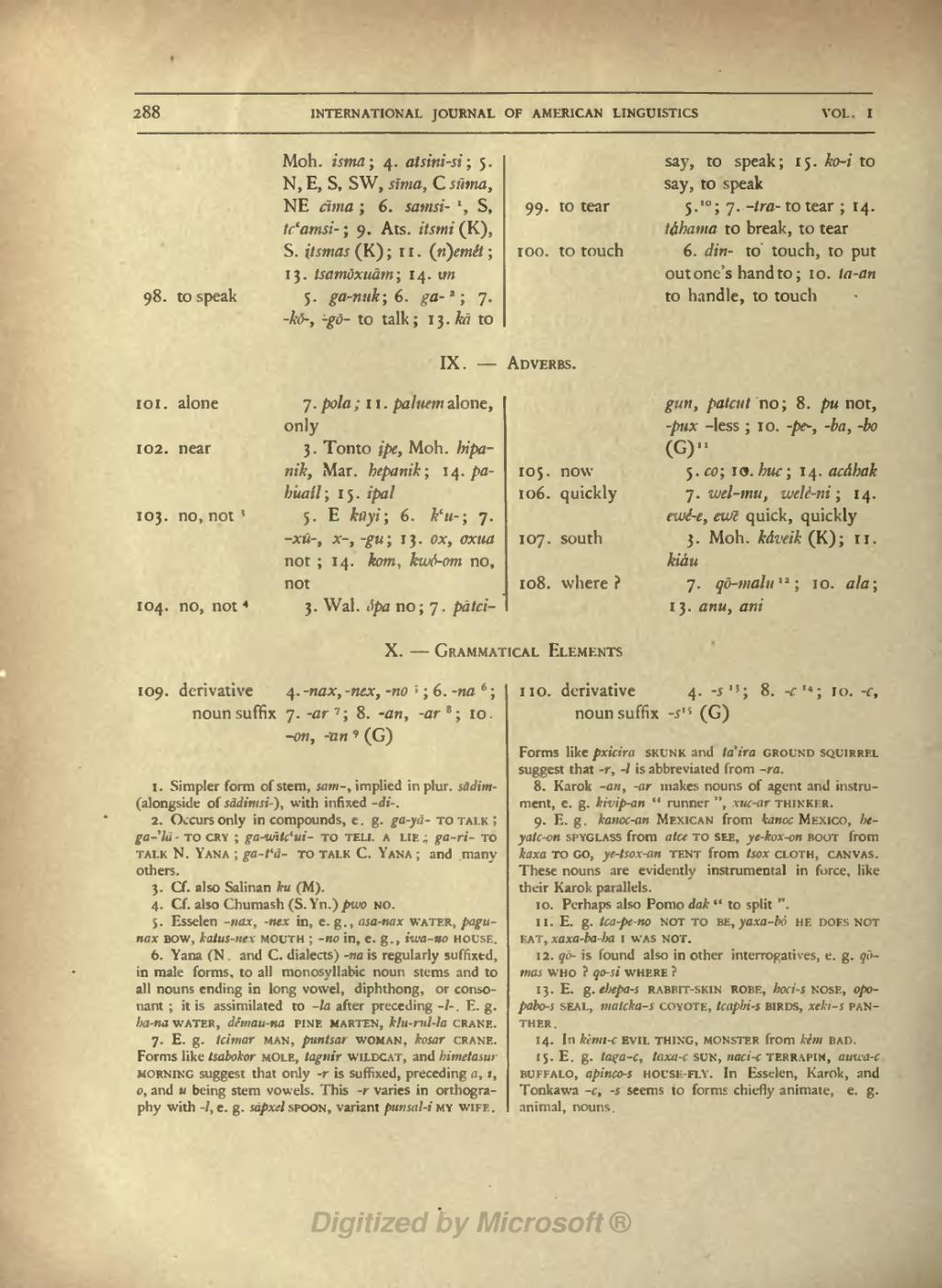288
��INTERNATIONAL JOURNAL OF AMERICAN LINGUISTICS
��VOL. I
��98. to speak
��101. alone
��102. near
��103. no, not '
��104. no, not
��Moh. isma ; 4. atsini-si ; 5. N, E, S, SW, sima, C sfima, NE tima ; 6. saw si- ', S, tc'amsi- ; 9. Ats. itsmi (K), S. {tsmas (K) ; 1 1 . (ti)emtt ; 13. tsamdxuam; 14. im
5. ga-nuk; 6. ga- 2 ; 7. -ko-, -go- to talk ; 13. ka to
IX. -
7 . pola ; n. paltteni alone, only
3. Tonto ipe, Moh. bipa- nil;, Mar. bepanik; 14. />a- /><///; 15. //>/
5. E /h?y/; 6. A-'/(-; 7. -.VM-, A--, -gu; 13. c.v, I'xna not ; 14. fc?m. kw6-om no, not
3. Wai. opa no ; 7 . /><;/<-;'-
��99. to tear too. to touch
��say, to speak ; 15. ko-i to say, to speak
5.'; 7. -tra- to tear ; 14. tabaina to break, to tear
6. din- to' touch, to put out one's hand to; 10. ta-an to handle, to touch
��ADVERBS.
��105. now
106. quickly
107. south
108. where ?
��gun, patent no; 8. pu not, -piix -less ; 10. -pe-, -ba, -bo (G)"
5. co; 19. hue 514. acdbak
j. wel-mu, luele-ni ; 14. ewt-e, ewe quick, quickly
3. Moh. kdveik (K); u. kiiiu
7. qo-malii '* ; 10. a/a; 13. ami, an/
��X. GRAMMATICAL ELEMENTS
��109. derivative .\.->uix, -nex, -no ; 6. -na 6 ; noun suffix 7. -m "'; 8. -aw, -ar 8 ; 10. -on, -nn 9 (G)
��1. Simpler form of stem, sum-, implied in plur. sfiJim- (alongside of siiJimsi-), with infixed -Ji-.
2. Occurs only in compounds, e. g. ga-yii- TO TALK : ga-'Iii- TO CRY ; ga-witc'ui- TO TEI.I. A LIE 4 ga-ri- TO TALK N. YANA ; ga-t'ii- TO TALK C. YANA ; and .many others.
3. Cf. also Salinan kit (M).
4. Cf. also Chumash (S. \D.) pwo NO.
5. Ksselen -nax, -nex in, e. g., asa-nax WATER, pagu- mi.v BOW, katin-nex MOUTH ; -no in, e. g., iu'ti-uo HOUSE.
6. Yana (N. and C. dialects) -na is regularly suffixtd, in male forms, to all monosyllabic noun stems and to all nouns ending in long vowel, diphthong, or conso- nant ; it is assimilated to -la after preceding -/-. E. g. lia-na WATER, df'mait-na PINE MARTEN, klu-rul-hi CRANE.
7. E. g. tcimar MAN, funtsar WOMAN, kosar CRANE. Forms like tsabokor MOLE, tagnir WILDCAT, and himetmur MORNING suggest that only -r is suffixed, preceding a, i, o, and u being stem vowels. This -r varies in orthogra- phy with -/, e. g. sapxel SPOON, variant fwnsal-i MY WIFE .
��no. derivative 4. -s n ', 8. -r " ;
noun suffix -.f' s (G)
��10. -c,
��Forms like pxicira SKUNK and ta'ira GROUND SQUIRREL suggest that -r, -I is abbreviated from -;.
K. Karok -an, -ar makes nouns of agent and instru- ment, c. g. kivip-an " runner ", xw-ar THINKI R.
9. E. g. kanoc-an MEXICAN from (\inn- MEXICO, he- yatc-on SPYGLASS from atce TO SEE, ye-kox-on HOOT from kaxa TO GO, yt-tsox-an TENT from tsox CLOTH, CANVAS. These nouns are evidently instrumental in force, like their Karok parallels.
10. Perhaps also Porno dak " to split ".
it. E. g. tca-pe-no NOT TO BE, yaxa-bo HE DOES NOT i. AT, xnxa-ba-l.<a i WAS NOT.
12. </r>- is found also in other interrogatives, e. mas WHO ? go-si WHERE ?
13. E. g. cbepa-s RABBIT-SKIN ROBE, lioci-s NOSE, opo- pubo-s SEAL, imitcka-s COYOTE, tcapln-s BIRDS, xeki-s PAN- THER.
14. In kimi-c EVIL THING, MONSTER from keni BAD. 15.!:. g. tin'ii-c, luxii-c SUN, naci-c TERRAPIN, auu\i-c
BUFFALO, apinco-s HOUSE-FLY. In Esselen, Karok, and Tonkawa -c, -s seems to forms chiefly animate, e. g. animal, nouns.
�� �
